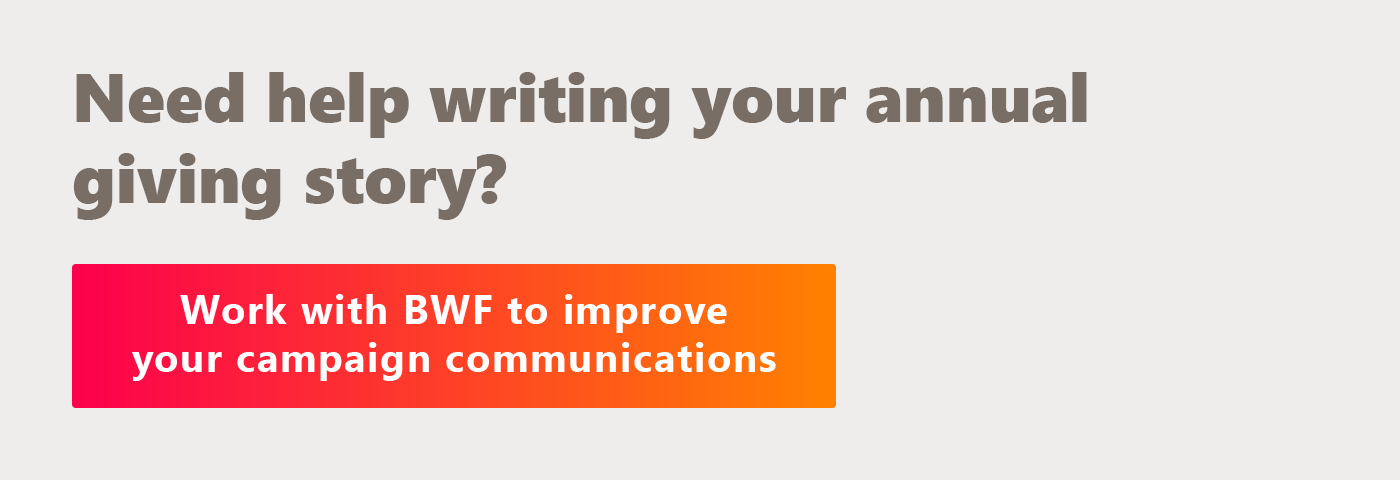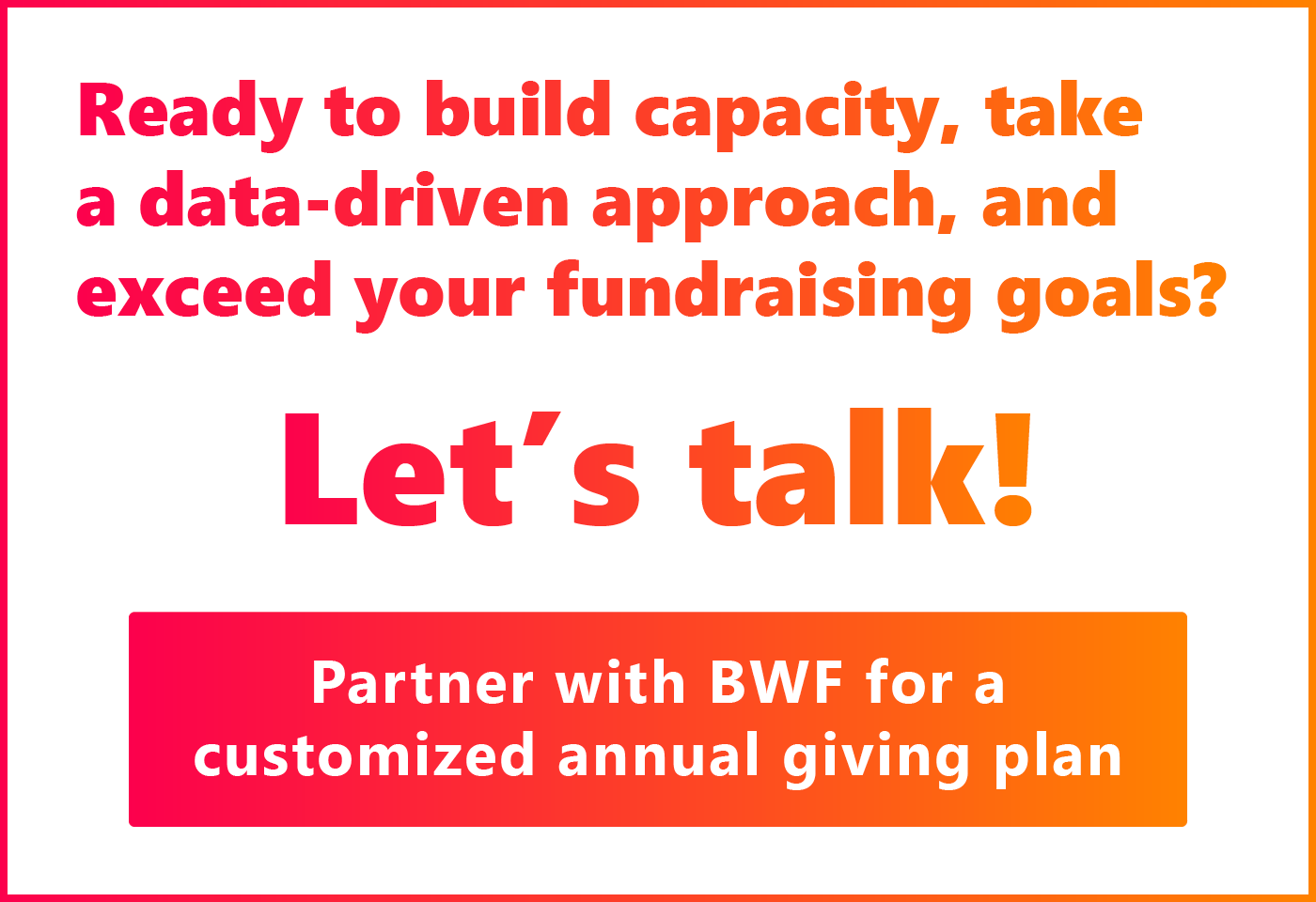Annual giving supports a nonprofit’s or university’s efforts to raise ongoing funding throughout the year to support projects, programs, and other daily operations.
By creating an annual giving pipeline that continually encourages audience members to become donors, you can create a self-sustaining program that brings in reliable funding year after year.
In this guide, we’ll cover the annual giving essentials, including:
- What is Annual Giving?
- Why is Annual Giving So Important?
- 8 Steps to Build Your Annual Giving Campaign
In this post-pandemic, digital-first fundraising environment, donors have new expectations for interacting with their favorite nonprofits and universities. They expect meaningful engagement, personalized interactions, and curated experiences that speak directly to their motivations and needs. With these eight steps, you can develop an annual giving strategy that appeals to donors’ desires for compelling, tailored experiences.
What is Annual Giving?
Annual giving involves the campaigns, strategies, and initiatives nonprofits, universities, museums, healthcare organizations, and other organizations use to raise a steady, sustainable fundraising stream each year.
Annual giving campaigns can take place at any point during the year, but the year-end giving season tends to be the most important fundraising period due to donors submitting their final tax-deductible gifts for the year.
Why is Annual Giving So Important?
Before we dive into the specifics of creating an annual giving strategy, it’s important to understand what makes annual giving such a crucial part of a nonprofit’s fundraising efforts. Creating a clear plan is necessary because annual giving:
- Provides a reliable, unrestricted fundraising source. For most organizations, annual fund donations are unrestricted gifts, meaning they can be used for any purpose. Other campaigns, like capital campaigns, focus on restricted funds—money that has to be used for a single defined purpose. Building up your annual fund provides access to a sustainable funding source to help pay for everyday expenses and operation costs.
- Helps you engage donors. Through the process of developing an annual giving strategy, you can create a pipeline of loyal donors with your current outreach efforts to engage both existing and new donors and give them an easy way to support your cause.
- Gives donors a fulfilling opportunity to direct their funding. Annual giving offers benefits to donors as well. They can direct their funding to something that helps your organization operate on a daily basis. Knowing their funds will go directly toward mission-critical needs can help them feel a greater sense of pride and accomplishment. Plus, when you create a donor society or sustained monthly giving program for donors, you can create an exclusive group that makes supporters feel more connected to your cause.
Nonprofits and universities have all kinds of ongoing expenses, from overhead costs like rent and utilities to employee salaries. With a robust annual fund, you can ensure that your basic costs are covered and that you’re able to direct more funding toward projects and programs that directly impact your mission.
8 Steps to Build Your Annual Giving Campaign
Annual giving campaigns require careful planning to be successful. Let’s take a look at each element of the process.
1. Recruit your annual giving team.
Your annual giving strategy will require the support of multiple team members. Annual giving responsibilities are divided among development team members, meaning no one is responsible for the entirety of the strategy on their own.
A few individuals involved in the planning and management of an annual giving strategy might be:
- The executive director of annual giving
- The director of annual giving or the associate/assistant director of annual giving
- The associate director of direct response
- The associate director of constituent marketing
- The associate/assistant vice president of annual giving and digital engagement
With everyone having other responsibilities, it can sometimes be challenging for development teams to make annual giving a top priority. Staff members are frequently diverted from core annual giving responsibilities to troubleshoot issues and assist with other work.
That makes clear communication between team members essential. As you identify your annual giving team members, assign each individual clear deliverables that they will take responsibility for throughout the year. Also, develop a centralized reporting system for team members to submit their updates and track their progress.
In the long term, it can be highly beneficial to work with a fundraising consulting firm to provide guidance and support to your annual giving team. Fundraising consultants can also provide expertise and advice for creating your team’s accountability structure and fostering open communication.
2. Define your annual fund goals.
Establishing clear, attainable goals will set your annual giving strategy in motion and give your team something to strive for. We recommend using a TEAM framework to orient your goal-setting process:
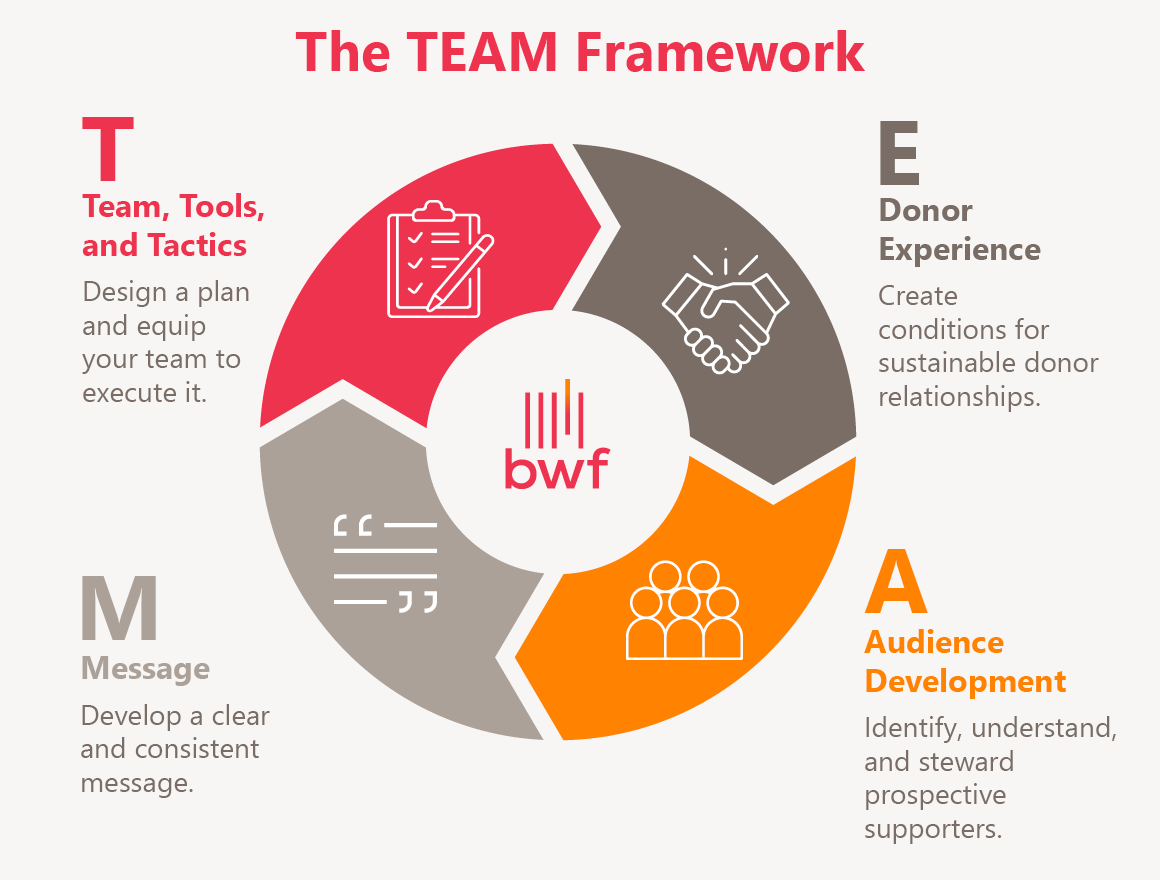
This framework helps define the areas where you want to set quantifiable goals, including those relevant to donor experience, messaging, and audience development. It should also narrow down your revenue objectives and give your team a target fundraising amount to hit.
Your ultimate goal with any annual giving campaign is to build and strengthen your donor engagement and fundraising pipeline. With a strong pipeline, you can increase your supporter retention rate and create sustainable donor relationships.
With this in mind, consider setting goals related to:
- Pipeline development. In its most basic form, pipeline development is measured in donor counts— how many donors your organization was able to engage throughout the campaign. Emphasis is placed on the volume of supporters and resources are allocated to build a base of support for the future.
- Revenue generation. Revenue generation goals are measured in dollars raised. This includes metrics like total amount raised, total online donations raised, total matching gifts accepted, etc. Resources are allocated to maximize giving now rather than in the future.
Keep in mind that your goals should be specific and measurable. For instance, don’t just create a goal to engage more donors, or raise more revenue than last year. Set a goal to engage at least 6,000 donors and raise at least $1 million. This way, when you run reports, you can clearly see how close your team is to achieving goals.
3. Identify metrics to track.
Metrics allow you to track progress made toward your goals using quantitative data. Depending on what your nonprofit’s specific annual giving goals are, you might track metrics such as:
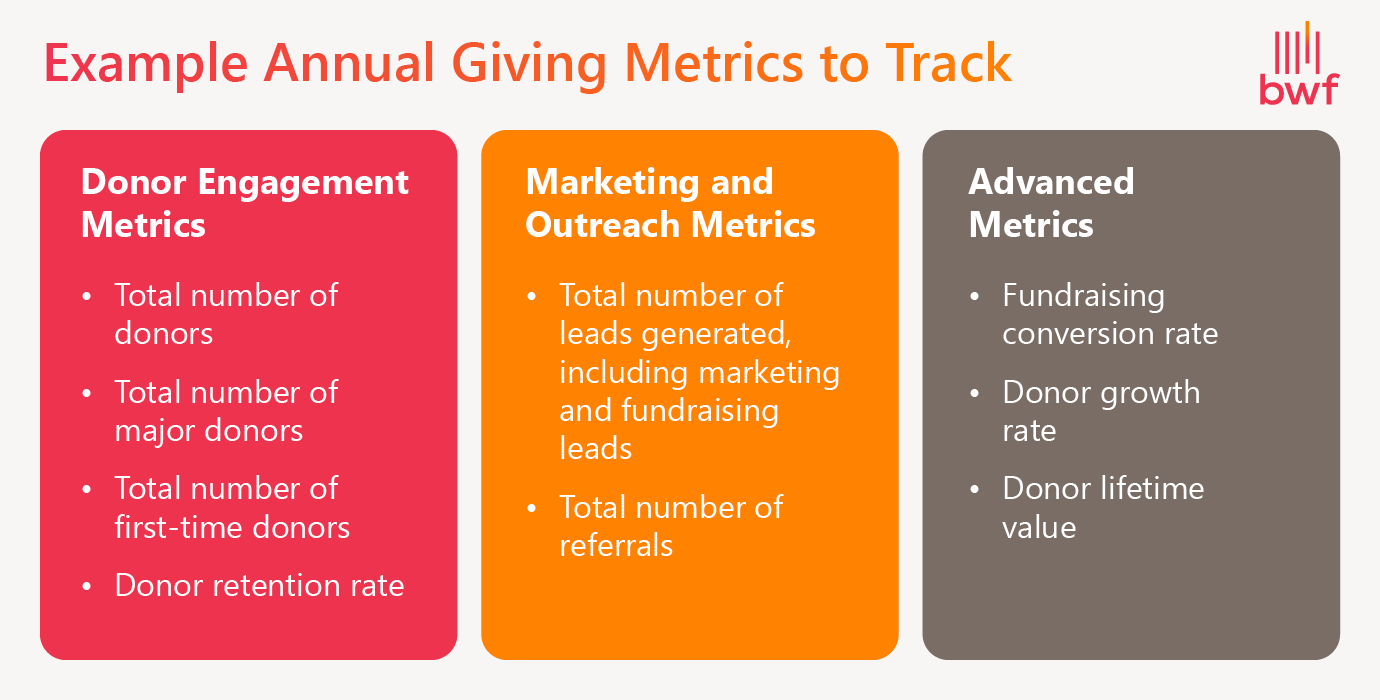
- The total number of donors
- The total number of major donors (however your organization defines this category)
- The number of first-time donors
- Donor retention rate
- The number of leads generated, including marketing and fundraising leads
Choose your metrics and set up your reporting processes early on to keep your development team on the same page. Make sure each team member knows which metric they’re in charge of updating and when they should run reports.
4. Develop your lead generation strategy.
Audience development is a core component of creating a strong annual giving pipeline. So, how will you find donors for your annual giving campaign?
You can find leads by engaging with these four types of supporters: those who’ve participated in an event or other non-donation opportunity with your organization, those who’ve interacted with your organization online, those who use your services or have visited your facilities, and those who have given to your cause.
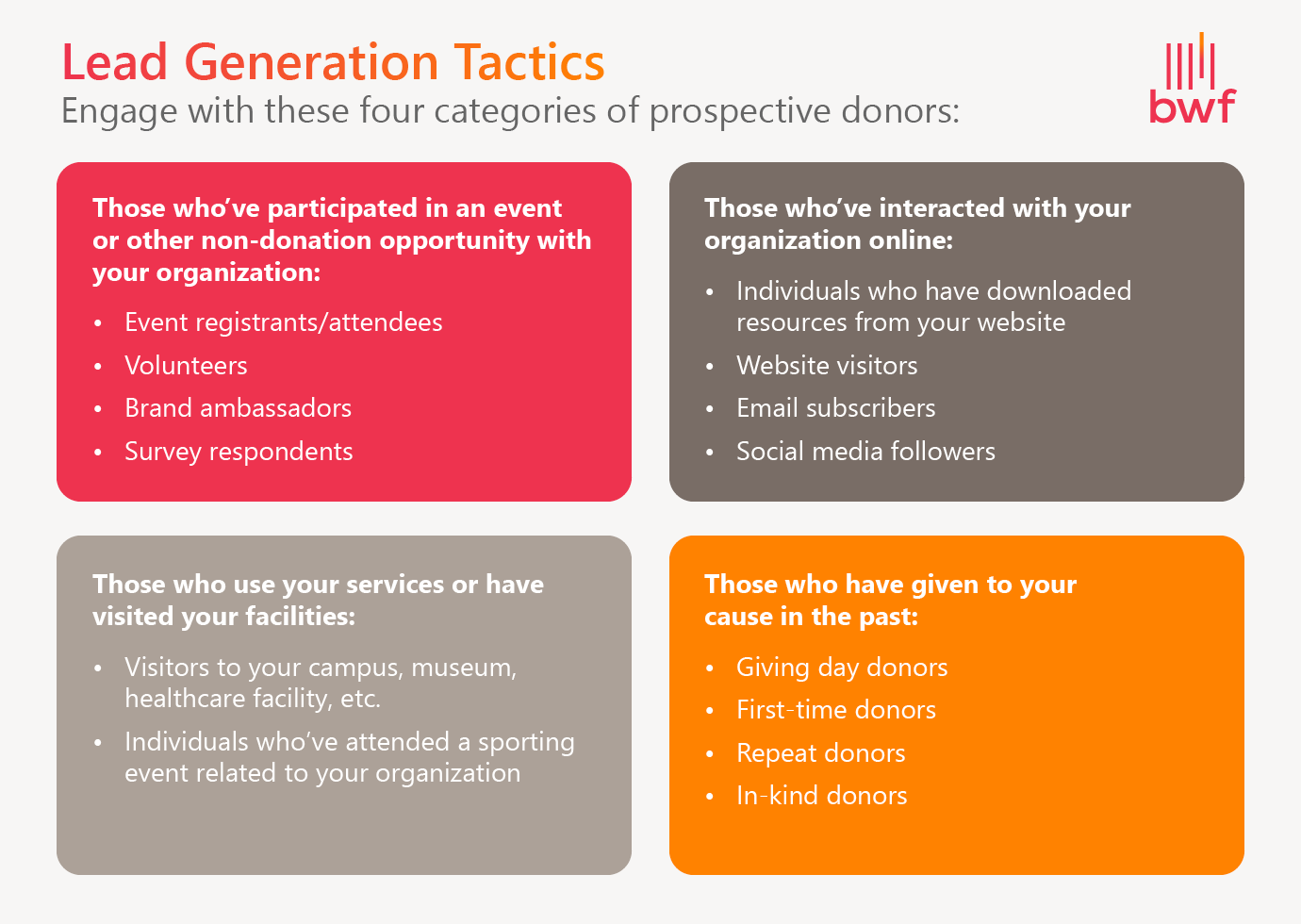
For example, your organization might have a broad audience that includes:
- Past donors, including first-time donors, recurring donors, in-kind donors, giving day donors, donors who recently upgraded their gift amount, etc.
- Past event attendees
- Volunteers
- Social media followers
- Those who have used your services in the past
- Website visitors
After identifying your core audiences, you can create specialized strategies for engaging each group. One of those strategies is segmentation, which we’ll discuss later on.
5. Write your annual giving story.
Your annual giving story is the compelling, creative narrative that your nonprofit uses to communicate the impact of a gift to prospective donors. When your messaging aligns with your audience and the communication channel you’re using, you’ll be able to convince more prospects that your organization is worthy of their support.
Your story should summarize the purpose and goals of your organization’s annual fundraising campaign. It can be helpful to choose a campaign theme or slogan to give your annual giving strategy a single message to rally around.
For example, review the campaign slogans for these universities and how each organization uses its slogan to tell a story:
- The University of Missouri: Mizzou’s annual giving slogan “Every Tiger, Every Year” tells prospective supporters that giving, no matter the form, directly impacts students every day. This messaging makes it clear that it takes the support of everyone—alumni, friends, and parents—to help provide students with the excellent education they deserve.
- Arizona State University: The ASU Foundation at Arizona State University drives the school’s annual giving campaigns forward with the slogan “Building a better tomorrow.” This tells donors that their gifts will directly benefit future generations. Plus, ASU offers opportunities for donors to give to the causes that mean the most to them, whether serving the community, advancing student access, conducting research, and more. Donors appreciate having the opportunity to control where their funding goes.
- The University of Texas at Austin: UT Austin’s powerful annual giving campaign is called the “What Starts Here” campaign. The full slogan reads “What starts here changes the world. What starts here starts with you.” This statement makes it clear that the university can only reach its full potential with the help of generous donors.
When writing the annual giving story for your organization, keep these questions in mind:
- Do you have a clear and consistent message? Your annual giving story should focus on one core message rather than trying to incorporate everything your organization does.
- Is your case for support compelling? Have you given audience members a protagonist to root for throughout your story, whether a student, beneficiary, or volunteer? Have you connected this individual’s story to your greater mission? Is your overall case for support clear and convincing?
- Have you highlighted a clear value proposition for the donor? Ensure your message describes the benefits donors will receive by supporting your organization, whether it’s access to exclusive donor events, free merchandise, free publications, or something else.
- Is a journey model used to guide donor communications? Have you created clear donor pathways for each of your core audiences? Do you have a plan for guiding prospective donors to help them learn more about your cause and access donation opportunities that resonate with them?
To support your story with engaging imagery, videos, and anecdotes, gather compelling content from your audience and beneficiaries. For example, if you’re fundraising for your university, you can ask students to send photos and videos about what the school means to them. Rich content makes your annual giving story come to life.
5. Personalize outreach.
Segment your core audiences to send relevant content to each group and emphasize the parts of your annual giving story that resonate with different audiences.
For example, you might email your volunteers a story about how their recent efforts to build homes in your area have helped local families get back on their feet after a tragedy. Then, you can send them donation appeals emphasizing the fact that volunteers can take their support to the next level by giving.
Use different communication channels (email, social media, direct mail, phone) based on the preferences found in your past or general engagement data. Demographic data, in particular, can reveal donors’ communication preferences. For example, younger supporters tend to prefer digital communication methods, such as social media interactions, while older supporters appreciate emails and phone calls.
6. Steward donors.
Your annual giving campaign should include a variety of donor stewardship activities throughout the year to introduce prospective new donors to your cause and engage existing donors. Your donor stewardship plans may include:
- Calling prospective donors on the phone
- Hosting one-on-one in-person meetings
- Making sure donors know who to go to on your team to get their questions answered
You should provide the same positive experience to your existing supporters to secure their long-term support. Invite them to engage in multiple opportunities throughout the year and get involved in new aspects of your nonprofit. For instance, invite volunteers to donate or participate in peer-to-peer fundraisers, and donors to engage in volunteering or attend a webinar event.
Remember: It’s important to steward donors at all levels, not just major donors. Your lower and mid-tier donors are just as important to the success of your annual giving campaign, and these donors may someday have the capacity to become major donors themselves.
7. Consider creating a donor society.
Creating an annual donor society or membership program can help donors feel like members of an exclusive club.
For example, the Cleveland State University Foundation donor society is called the Green & White Society. Donors who make annual gifts of $1,000 or more gain access to this exclusive club. The Society includes tiered membership levels that correspond to donation amount, including Platinum, Gold, Silver, and Bronze.
When designing a donor society for your university or nonprofit, consider assigning different benefits to each donor tier. For example, those who give $1,000 or more may receive a personal phone call from the dean of students, while those who give $10,000 or more can gain access to an exclusive event.
Be sure to continually steward donor society members throughout the year using outreach mechanisms such as exclusive email newsletters, free merchandise, event opportunities, and more.
8. Express gratitude.
No annual giving campaign is complete without a comprehensive approach to thanking donors for their support. Send all donors heartfelt thank you letters and messages personalized with their names and references to their specific contributions. These messages can be emails, handwritten letters, phone calls, or social media direct messages.
Using a service like {{first name}}, you can even create personalized video content to send to donors, catching their attention and helping your organization stand out from the crowd.
Encourage donors to stay in touch by subscribing to your email newsletter or attending an upcoming event, such as a webinar or volunteer opportunity.
You can also use your thank-you messages as an opportunity to gather donor feedback. By asking donors for their input, you can show them that you’re dedicated to creating a donor experience that exceeds their expectations. Send out a short satisfaction survey asking questions such as:
- On a scale of 1-10, how convenient was the donation process?
- Do you have a clear idea of how your donation will be used?
- What is your preferred communication platform?
- How likely are you to donate to our organization again?
Use the feedback you receive to adjust your donor stewardship and other annual giving strategies moving forward.
Bonus Tip: Watch and learn from an annual giving expert.
In this helpful webinar, BWF’s own James Barnard dives deep into the intricacies of a successful annual giving strategy beyond what we’ve discussed in this article.
Check out this webinar recording to learn the following:
- How to create an annual giving strategy with objectives and metrics.
- How to develop lead generation and scoring models.
- How to create donor journeys and prospect warming campaigns.
- How to design the infrastructure to make it all work together.
Wrapping Up: Launching Your Annual Fund Strategy
Creating an annual giving strategy can be complicated, especially if your organization is a large university or nonprofit with complex fundraising needs. Working with digital fundraising and marketing professionals, such as the BWF team, can help make the process much more manageable.
BWF empowers organizations with comprehensive, resilient annual giving strategies. Our team can also set you up with a powerful donor engagement strategy, whether you’re interested in building a donor society, membership program, or grateful patient program. And for some of our clients, we even manage their entire annual giving program to ensure success and stability.
Ready to learn more about how BWF can help your organization find annual giving success? Contact us today to start the conversation.
For more information about what makes an annual giving strategy successful, review these additional resources from BWF:
- Digital Fundraising | 7 Powerful Campaign Ideas to Try. Digital engagement is critical to the success of your annual giving campaign. We explore seven powerful digital fundraising ideas in this guide.
- Building the Base. Creating a strong annual giving pipeline is all about building your donor base. Read all about BWF’s audience research and donor engagement services that help you foster a strong base.
- AI Fundraising is the Future. Here’s What You Need to Know. Learn how AI fundraising can help take your annual giving campaign to the next level with prospect development insights, predictive modeling, and more.
Let’s Talk
Find out how BWF can partner with you to optimize your annual giving strategy.


